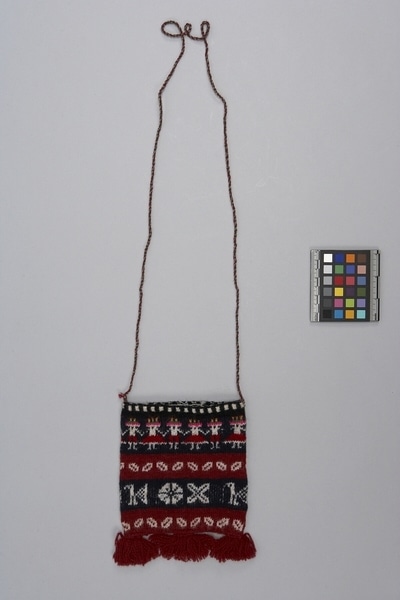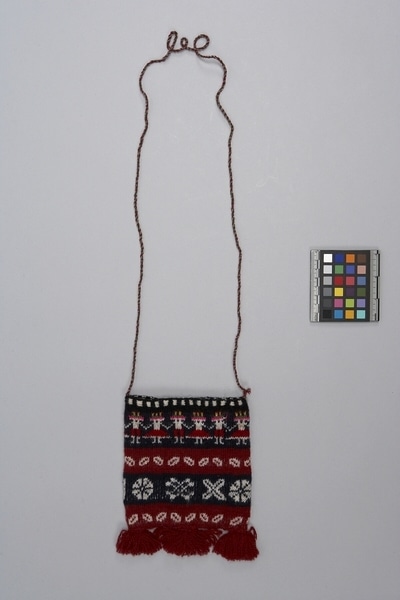Bag Item Number: Sf1006 from the MOA: University of British Columbia


Description
Rectangular knitted bag with a corded strap and three red tassels on the bottom. The bag faces are similar, each consisting of four bands with repeating patterns worked in white or coloured yarn against a dark red or a dark blue background. A border of dark blue and white squares surrounds the bag mouth. Next is a row of figures, alternately male and female, holding hands and wearing hats. Below this is a row of white oval shapes oriented on the diagonal. They repeat in reflective symmetry. Below this is a wider blue band with individual motifs of profile birds, segmented circles and crosses. The final band is like the second band. The bottom edge is sewn together and tassels are attached through the two larger ones. The handle is four strands of red, green and white twisted together then doubled.
History Of Use
Knitting is traditionally done on Taquile for men's and infant's hats. The neck purses were developed entirely as an item for sale to outsiders. They also modified a vest form they wore into a tourist sale item by putting knitted panels on the front. They now make a wider variety of hats in various colours, including one for women, to sell to tourists.
Narrative
Selvano is a 7 year old (c 1987) boy, who has been knitting since 1984 when he was 4. He knits monderas for sale to tourists. He sold this bag along with another that is partly completed.
Specific Techniques
Commercial yarns, probably synthetic, wholly or part, are z spun and plied 2-s. The bag is knitted in the round with 5 needles. Worked with the inside of the bag facing and worked with the purl stitch. Second colour is carried along inside.
Cultural Context
tourist craft
Iconographic Meaning
The figures of men and women holding hands represent the Sikuri dancers who wear feathered hats and wigs of hair or coloured ribbons.
Item History
- Made by Selvano Huatta Yucra (Maker) in Taquile, Puno, Peru during 1987
- Collected by Mary Frame during 1987
- Owned by Mary Frame before November 3, 1987
- Received from Mary Frame (Seller) and Museum of Anthropology Shop Volunteers (Funding source) on November 3, 1987
What
- Name
- Bag
- Identification Number
- Sf1006
- Type of Item
- bag
- Material
- synthetic fibre, wool fibre ? and dye
- Manufacturing Technique
- knitted, re-plied and sewn
- Overall
- height 69.3 cm, width 16.0 cm, depth 0.8 cm
Who
- Culture
- Quechua
- Creator
- Selvano Huatta Yucra (Maker)
- Field Collector
- Mary Frame
- Previous Owner
- Mary Frame
- Received from
- Mary Frame (Seller) and Museum of Anthropology Shop Volunteers (Funding source)
Where
- Holding Institution
- MOA: University of British Columbia
- Made in
- Taquile, Puno, Peru
When
- Creation Date
- during 1987
- Collection Date
- during 1987
- Ownership Date
- before November 3, 1987
- Acquisition Date
- on November 3, 1987
Other
- Item Classes
- textiles
- Condition
- good
- Accession Number
- 1274/0032